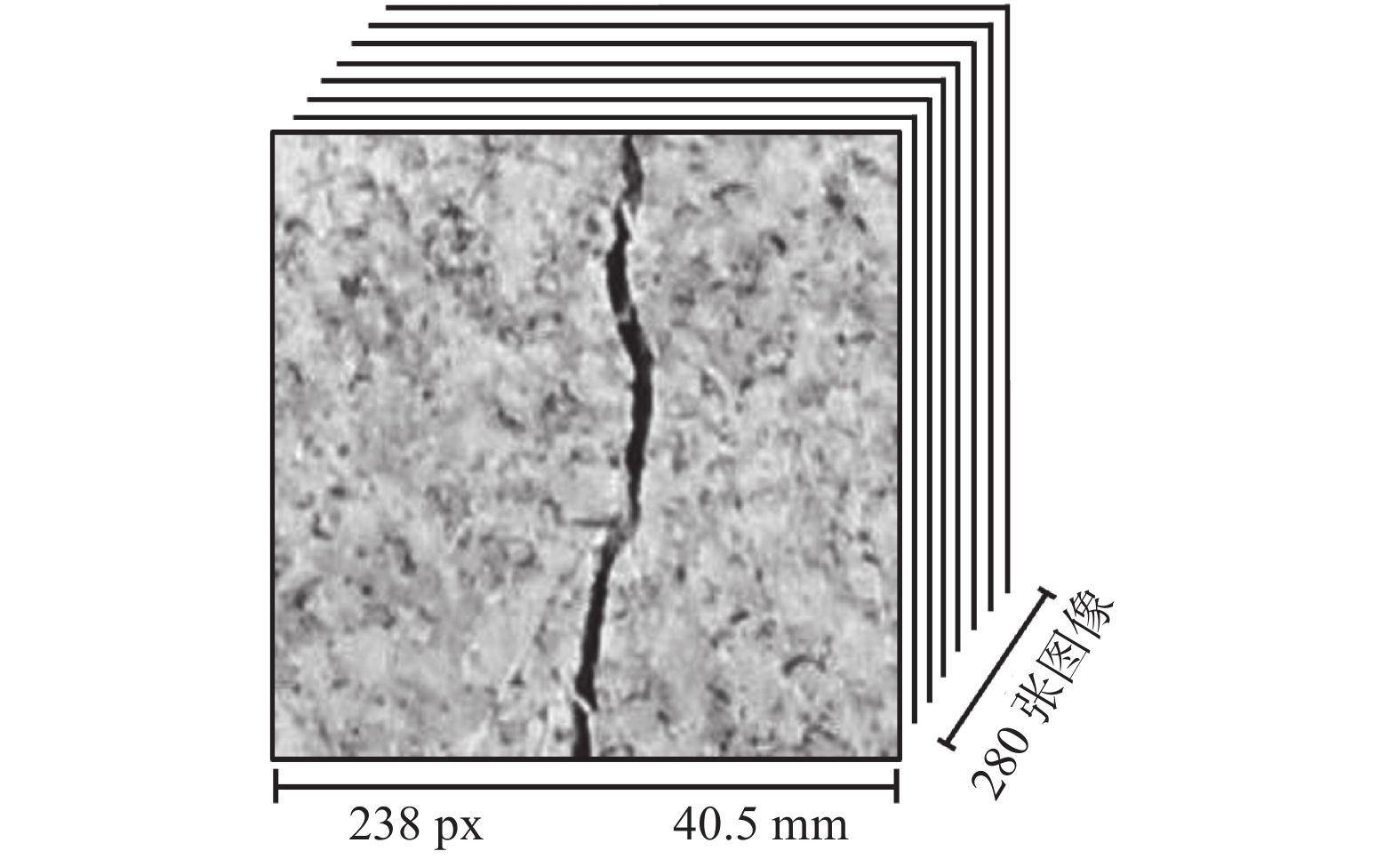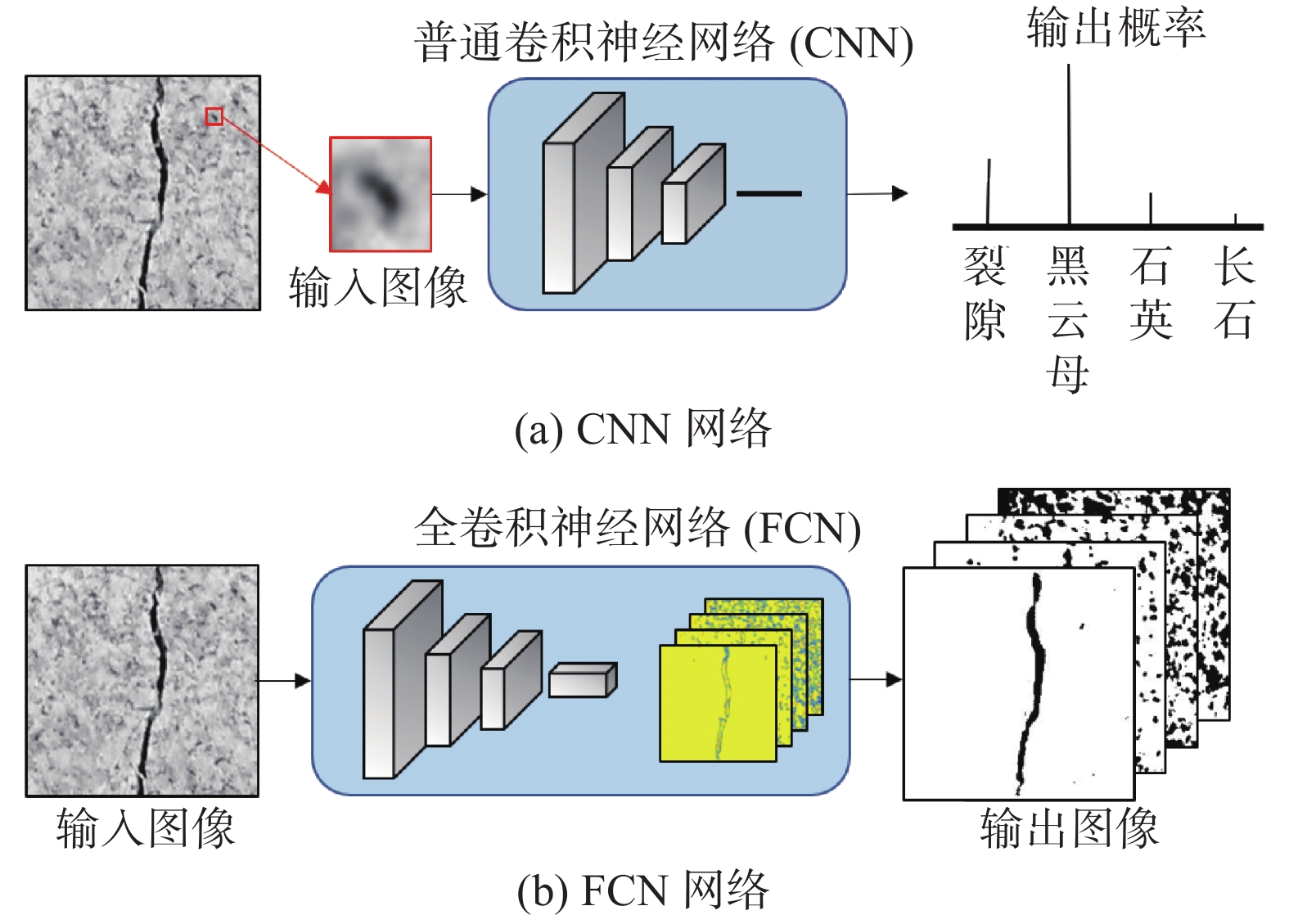Distributions of various compositions in granite specimen using fully convolutional network
-
摘要:
岩石中不同组分的分布特征是研究岩石物理力学性质的重要基础。本文以花岗岩为例,使用全卷积神经网络(FCN)和单轴压缩试验视频来研究花岗岩不同组分(裂隙、黑云母、石英、长石)的分布特征。将视频中单帧图像进行灰度转换和像素裁剪后,使用肉眼判定方法将4种组分进行标记并制成基础数据集,建立并训练了相应的FCN,通过对不同卷积层的可视化操作探讨了花岗岩中不同组分的分布情况,研究了整个变形破坏过程岩石中不同组分分布的变化特征,分析了不同组分识别准确率的变化情况及主要因素(网络深度、初始学习率和网络迭代次数)的影响。结果表明,在花岗岩的整个变形破坏过程中,裂隙首先在中部区域萌生、最后纵向贯穿整个岩石表面,黑云母组分分布分散且不断向左上方或右上方移动,石英主要集中在两侧区域,长石主要集中在中间和左上角区域;不同组分识别准确率逐步小幅度下降,准确率大小顺序是裂隙>黑云母>长石>石英;网络深度越深、初始学习率越大、则识别效果越好,迭代次数5000时的识别效果较好。研究结果对使用人工智能技术研究岩石中不同组分分布特征具有一定的参考价值。
Abstract:The distributions of various compositions are the fundamental issues in studying the physical and mechanical properties of rock material. In this study, fully convolutional network (FCN) and the video images photographed during the uniaxial compression test were used to study the distribution of various compositions (including crack, quartz, feldspar and biotite) in the granite specimen. After converting into the grayscale image and cropping the specimen in each frame extracted from the video image, the compositions are labeled to make a ground data set using the naked eye judgment method. A corresponding FCN is then established and trained. The distributions of these compositions are furthermore examined by visualizing various convolutional layers. The evolution features and influencing factors (including network depth, initial learning rate, and iterations) of the recognitions during the whole deformation/failure process were investigated. It shows that during the total deformation/failure process of the granite specimen the crack initiated in the central region and penetrated through the surface longitudinally, the biotite dispersedly distributed and moved continuously to the upper left or upper right parts, the quartz concentrated mainly in the sides, while the feldspar concentrated mainly in the middle and upper left parts; the recognition accuracy of various compositions decreased slightly with a descending order of crack > biotite > feldspar > quartz; the recognition was better with a deeper FCN and a greater initial learning rate, the recognition was good if the iteration is set at 5000. The above results may be referable in studying the distribution features of various compositions in rock by using of artificial intelligence.
-
Key words:
- granite /
- compositions recognition /
- fully convolutional network
-

-
表 1 全卷积神经网络的各层参数
Table 1. Parameters used in FCN
层序 名称 -2603519748500卷积核 步长 边缘填充像素 数量 大小 1 图像输入层 238×238×1 2 卷积层1 64 3×3 [1 1] [1 1 1 1] 3 ReLU层1 — 4 最大池化层1 1 2×2 [2 2] [0 0 0 0] 5 卷积层2 64 3×3 [1 1] [1 1 1 1] 6 ReLU层2 — 7 卷积层3 64 3×3 [1 1] [1 1 1 1] 8 ReLU层3 — 9 卷积层4 64 3×3 [1 1] [1 1 1 1] 10 ReLU层4 — 11 卷积层5 64 3×3 [1 1] [1 1 1 1] 12 ReLU层5 — 13 最大池化层5 1 2×2 [2 2] [0 0 0 0] 14 转置卷积层1 64 4×4 [2 2] [-1-1-1-1] 15 ReLU层1_1 — 16 转置卷积层2 64 4×4 [2 2] [0 0 0 0] 17 ReLU层2_1 — 18 全卷积层 4 1×1 [1 1] [0 0 0 0] 19 Softmax层 — 20 像素分类层 — 21 图像输出层 238×238×1 表 2 所建FCN的全局准确率计算结果
Table 2. Global Accuracies of established FCN
网络深度 网络迭代次数 初始学习率r 0.001 0.002 0.004 0.006 0.008 17层 2600 0.847 0.848 0.855 0.863 0.871 5000 0.849 0.854 0.873 0.864 0.887 6600 0.851 0.855 0.857 0.864 0.874 19层 2600 0.849 0.857 0.864 0.866 0.874 5000 0.851 0.863 0.884 0.878 0.894 6600 0.854 0.861 0.874 0.869 0.877 21层 2600 0.848 0.860 0.874 0.881 0.875 5000 0.847 0.866 0.891 0.896 0.900 6600 0.855 0.875 0.882 0.880 0.883 -
[1] 徐永进, 滕奇志, 吴晓红, 等. 利用层间相关性的岩心CT图像半自动分割方法[J]. 中国图象图形学报,2015,20(10):1340 − 1345. [XU Yongjin, TENG Qizhi, WU Xiaohong, et al. Semi-segmentation of rock CT images using the correlation of adjacent frames[J]. Journal of Image and Graphics,2015,20(10):1340 − 1345. (in Chinese with English abstract) doi: 10.11834/jig.20151007
[2] 张嘉凡, 张雪娇, 杨更社, 等. 基于聚类算法的岩石CT图像分割及量化方法[J]. 西安科技大学学报,2016,36(2):171 − 175. [ZHANG Jiafan, ZHANG Xuejiao, YANG Gengshe, et al. A method of rock CT image segmentation and quantification based on clustering algorithm[J]. Journal of Xi'an University of Science and Technology,2016,36(2):171 − 175. (in Chinese with English abstract)
[3] 钱庆波, 徐金明, 黄继忠. 基于PFC2D的花岗岩新生裂隙萌生扩展过程分析[J]. 中国地质灾害与防治学报,2019,30(5):122 − 130. [QIAN Qingbo, XU Jinming, HUANG Jizhong. Analysis on the initiation and propagation of newly-generated cracks in granite using PFC2D[J]. The Chinese Journal of Geological Hazard and Control,2019,30(5):122 − 130. (in Chinese with English abstract)
[4] 朱赛楠, 李滨, 冯振. 三峡库区侏罗系泥岩CT损伤特性试验研究[J]. 水文地质工程地质,2016,43(1):72 − 78. [ZHU Sainan, LI Bin, FENG Zhen. Research on CT damage characteristics of the Jurassic mudstones in the Three Gorges Reservoir area[J]. Hydrogeology & Engineering Geology,2016,43(1):72 − 78. (in Chinese with English abstract)
[5] 刘春, 许强, 施斌, 等. 岩石颗粒与孔隙系统数字图像识别方法及应用[J]. 岩土工程学报,2018,40(5):925 − 931. [LIU Chun, XU Qiang, SHI Bin, et al. Digital image recognition method of rock particle and pore system and its application[J]. Chinese Journal of Geotechnical Engineering,2018,40(5):925 − 931. (in Chinese with English abstract) doi: 10.11779/CJGE201805018
[6] 简文星, 余锦风, 任佳, 等. 基于matlab的岩石表面裂纹统计方法[J]. 安全与环境工程,2015,22(5):128 − 133. [JIAN Wenxing, YU Jinfeng, REN Jia, et al. The statistical method of rock surface crack based on Matlab[J]. Safety and Environmental Engineering,2015,22(5):128 − 133. (in Chinese with English abstract)
[7] KRIZHEVSKY A, SUTSKEVER I, HINTON G E. ImageNet classification with deep convolutional neural networks[J]. Communications of the ACM,2017,60(6):84 − 90. doi: 10.1145/3065386
[8] SIMONYAN K, ZISSERMAN A. Very deep convolutional networks for large-scale image recognition[EB/OL]. 2014: arXiv: 1409.1556[cs. CV]. https://arxiv.org/abs/1409.1556
[9] GIRSHICK R, DONAHUE J, DARRELL T, MALIK J. Rich feature hierarchies for accurate object detection and semantic segmentation [C]. Computer Vision and Pattern Recognition, 2014, 580-587.
[10] GIRSHICK R. Fast R-CNN [C]. International Conference on Computer Vision, 2015, 1440-1448.
[11] REN S Q, HE K M, GIRSHICK R, et al. Faster R-CNN: towards real-time object detection with region proposal networks[J]. IEEE Transactions on Pattern Analysis and Machine Intelligence,2017,39(6):1137 − 1149. doi: 10.1109/TPAMI.2016.2577031
[12] HE K, GKIOXARI G, DOLLAR P, GIRSHICK R. Mask R-CNN [C]. Computer Vision and Pattern Recognition, 2017, 2961-2969.
[13] LIN T, DOLLAR P, GIRSHICK R, HE K, HARIHARAN B, BELONGIE S. Feature pyramid networks for object detection [C]. Computer Vision and Pattern Recognition, 2017, 2117-2125.
[14] BADRINARAYANAN V, KENDALL A, CIPOLLA R. SegNet: a deep convolutional encoder-decoder architecture for image segmentation[J]. IEEE Transactions on Pattern Analysis and Machine Intelligence,2017,39(12):2481 − 2495. doi: 10.1109/TPAMI.2016.2644615
[15] LONG J, SHELHAMER E, DARRELL T. Fully convolutional networks for semantic segmentation [C]. Computer Vision and Pattern Recognition, 2015, 3431-3440.
[16] 王振, 张善文, 王献锋. 基于改进全卷积神经网络的黄瓜叶部病斑分割方法[J]. 江苏农业学报,2019,35(5):1054 − 1060. [WANG Zhen, ZHANG Shanwen, WANG Xianfeng. Method for segmentation of cucumber leaf lesions based on improved full convolution neural network[J]. Jiangsu Journal of Agricultural Sciences,2019,35(5):1054 − 1060. (in Chinese with English abstract) doi: 10.3969/j.issn.1000-4440.2019.05.008
[17] 黄英来, 刘亚檀, 任洪娥. 基于全卷积神经网络的林木图像分割[J]. 计算机工程与应用,2019,55(4):219 − 224. [HUANG Yinglai, LIU Yatan, REN Honge. Segmentation of forest image based on fully convolutional neural network[J]. Computer Engineering and Applications,2019,55(4):219 − 224. (in Chinese) doi: 10.3778/j.issn.1002-8331.1808-0008
[18] RONNEBERGER O, FISCHER P, BROX T. U-net: Convolutional networks for biomedical image segmentation [C]. Medical image computing and computer assisted intervention, 2015, 234-241.
[19] 黄龙, 杨媛, 王庆军, 等. 结合全卷积神经网络的室内场景分割[J]. 中国图象图形学报,2019,24(1):64 − 72. [HUANG Long, YANG Yuan, WANG Qingjun, et al. Indoor scene segmentation based on fully convolutional neural networks[J]. Journal of Image and Graphics,2019,24(1):64 − 72. (in Chinese with English abstract) doi: 10.11834/jig.180364
[20] 郑婷月, 唐晨, 雷振坤. 基于全卷积神经网络的多尺度视网膜血管分割[J]. 光学学报,2019,39(2):0211002. [ZHENG Tingyue, TANG Chen, LEI Zhenkun. Multi-scale retinal vessel segmentation based on fully convolutional neural network[J]. Acta Optica Sinica,2019,39(2):0211002. (in Chinese with English abstract) doi: 10.3788/AOS201939.0211002
[21] LECUN Y, BOTTOU L, BENGIO Y, et al. Gradient-based learning applied to document recognition[J]. Proceedings of the IEEE,1998,86(11):2278 − 2324. doi: 10.1109/5.726791
-




 下载:
下载:





